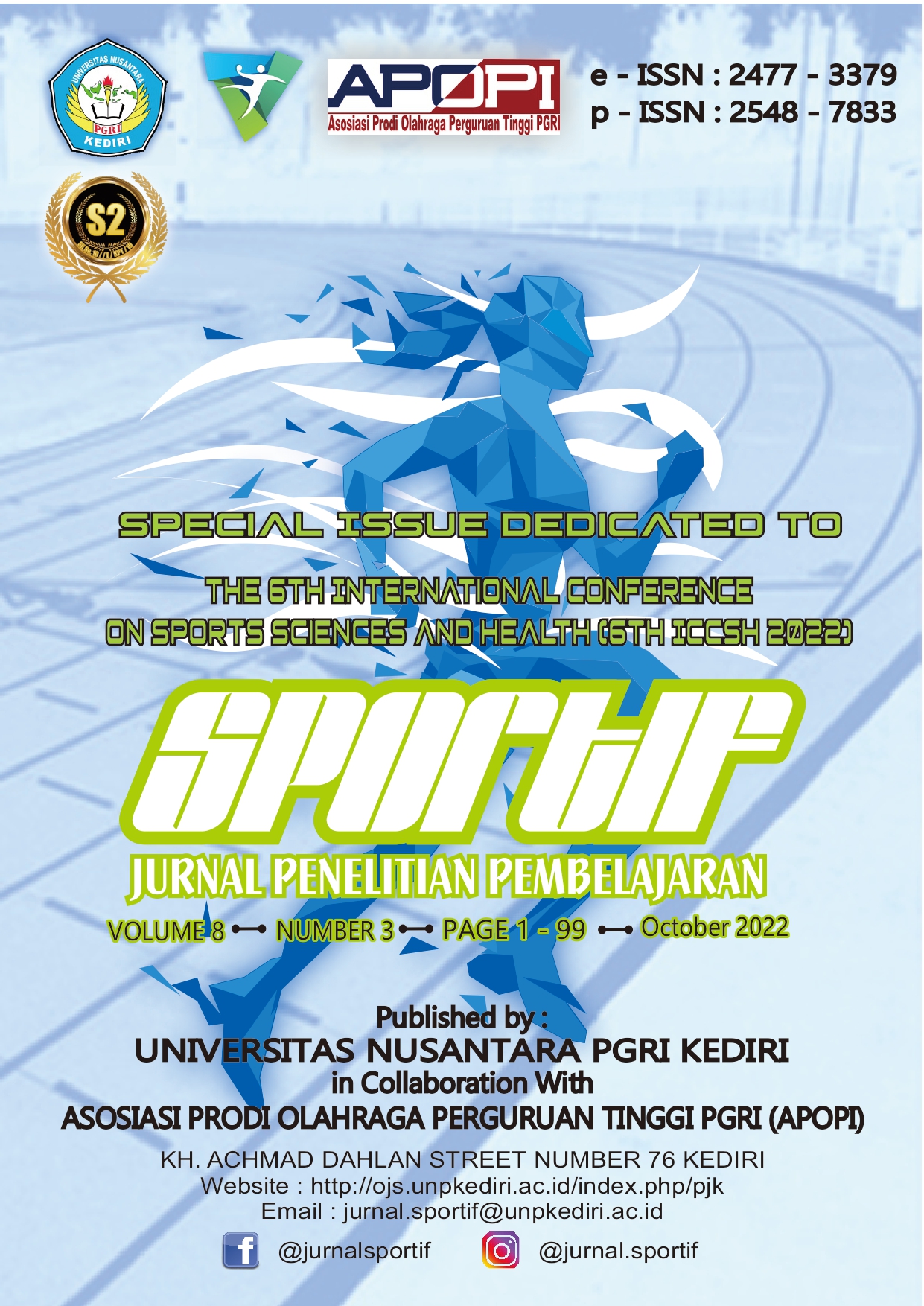Abstract
Due to a number of circumstances, such as heightened societal pressure, a lack of proper safety measures, and an emotionally taxing setting where many patients are suddenly dying, alone and afraid, the COVID-19 pandemic is having adverse effects on people's well-being. Despite the current circumstances, it is critical that learning continues in this unpredictable context. In an effort to aid students' well-being and development, the researcher analyzed the ability to manage one's well-being, especially in this pandemic for students enrolled in physical education. Materials and methods. This study was conducted to assess the management of the well-being of pre-service physical education teachers at the Batangas State University JPLPC-Malvar campus during the pandemic with the goal of determining the implications for physical education. This study utilized descriptive–correlational research using a questionnaire as the primary tool for gathering quantitative data, which was subjected to statistical analysis by employing frequency and percentage, mean and standard deviation, and chi-square. Results. From the data collected, well-being during the pandemic is considerably managed in terms of feeling pleased, appreciative, and proud when completing assigned responsibilities. Sex and socioeconomic position are considerably associated with the respondent's well-being management during the pandemic. Results show that based on the respondent's assessment of their well-being, it was highly managed; therefore, a proposed program to fully strengthen and revitalize the management of well-being should be implemented and included in the teaching process of physical health and wellness for pre-service physical education teachers.
References
Beddington, J., Cooper, C. L., Field, J., Goswami, U., Huppert, F. A., Jenkins, R., Jones, H. S., Kirkwood, T. B. L., Sahakian, B. J., & Thomas, S. M. (2008). The mental wealth of nations. In Nature (Vol. 455, Issue 7216). https://doi.org/10.1038/4551057a
Butze, O. (2020). How Researchers, Instructors, and students can practice well-being during the Covid 19 Pandemic. Social Science Space. https://www.socialsciencespace.com/2020/04/how-researchers-instructors-and-students-can-practice-well-being-during-the-covid-19-pandemic/
Coughenour, C., Gakh, M., Pharr, J. R., Bungum, T., & Jalene, S. (2021). Changes in Depression and Physical Activity Among College Students on a Diverse Campus After a COVID-19 Stay-at-Home Order. Journal of Community Health, 46(4). https://doi.org/10.1007/s10900-020-00918-5
Creswell, J. W. (2012). Educational research: Planning, conducting, and evaluating quantitative and qualitative research. In Educational Research. https://doi.org/10.1017/CBO9781107415324.004
Epel, E. (2020). Emotional well-being and Coping during Covid 19. Stress Scientist and Vice Chair of Adult Psychology. https://www.wellesley.edu/sites/default/files/assets/departments/humanresources/files/benefits/emotional_well-being_and_coping_during_covid-19_.pdf
Fredrickson, B. L., Cohn, M. A., Coffey, K. A., Pek, J., & Finkel, S. M. (2008). Open Hearts Build Lives: Positive Emotions, Induced Through Loving-Kindness Meditation, Build Consequential Personal Resources. Journal of Personality and Social Psychology, 95(5). https://doi.org/10.1037/a0013262
Fredrickson, B. L., & Joiner, T. (2018). Reflections on Positive Emotions and Upward Spirals. Perspectives on Psychological Science, 13(2). https://doi.org/10.1177/1745691617692106
Graham, C., & Chattopadhyay, S. (2013). Gender and well-being around the world. International Journal of Happiness and Development, 1(2). https://doi.org/10.1504/ijhd.2013.055648
Huang, X., Wei, F., Hu, L., Wen, L., & Chen, K. (2020). Epidemiology and clinical characteristics of COVID-19. In Archives of Iranian Medicine (Vol. 23, Issue 4). https://doi.org/10.34172/aim.2020.09
Jena, P. K. (2020). Impact of Pandemic COVID-19 on Education in India. International Journal of Current Research (IJCR). https://doi.org/10.31235/osf.io/2kasu
Kadariya, S., Gautam, R., & Aro, A. R. (2019). Physical Activity, Mental Health, and Well-being among Older Adults in South and Southeast Asia: A Scoping Review. In BioMed Research International (Vol. 2019). https://doi.org/10.1155/2019/6752182
McCloughen, A., Foster, K., Huws-Thomas, M., & Delgado, C. (2012). Physical health and well-being of emerging and young adults with mental illness: An integrative review of international literature. In International Journal of Mental Health Nursing (Vol. 21, Issue 3). https://doi.org/10.1111/j.1447-0349.2011.00796.x
Miyamoto, Y., & Ryff, C. D. (2011). Cultural differences in the dialectical and non-dialectical emotional styles and their implications for health. Cognition and Emotion, 25(1). https://doi.org/10.1080/02699931003612114
Stepanović, S. (2020). The impact of the COVID-19 pandemic on education. Nastava i Vaspitanje, 69(2), 183–196. https://doi.org/10.5937/nasvas2002183s
Tanhan, A., Yavuz, K. F., Young, J. S., Nalbant, A., Arslan, G., Yıldırım, M., Ulusoy, S., Genç, E., Uğur, E., & Çiçek, İ. (2020). A proposed framework based on the literature review of online contextual mental health services to enhance well-being and address psychopathology during covid-19. Electronic Journal of General Medicine, 17(6), 1–11. https://doi.org/10.29333/ejgm/8316
Zengin, M., Yayan, E. H., & Vicnelioğlu, E. (2021). The effects of the COVID-19 pandemic on children’s lifestyles and anxiety levels. Journal of Child and Adolescent Psychiatric Nursing, 34(3). https://doi.org/10.1111/jcap.12316
Authors who publish with this journal agree to the following terms:
- Copyright on any article is retained by the author(s).
- The author grants the journal, the right of first publication with the work simultaneously licensed under a Creative Commons Attribution License that allows others to share the work with an acknowledgment of the work’s authorship and initial publication in this journal.
- Authors are able to enter into separate, additional contractual arrangements for the non-exclusive distribution of the journal’s published version of the work (e.g., post it to an institutional repository or publish it in a book), with an acknowledgment of its initial publication in this journal.
- Authors are permitted and encouraged to post their work online (e.g., in institutional repositories or on their website) prior to and during the submission process, as it can lead to productive exchanges, as well as earlier and greater citation of published work.
- The article and any associated published material is distributed under the Creative Commons Attribution-ShareAlike 4.0 International License





